Pemmican: The Ancient Superfood Every Prepper Should Know
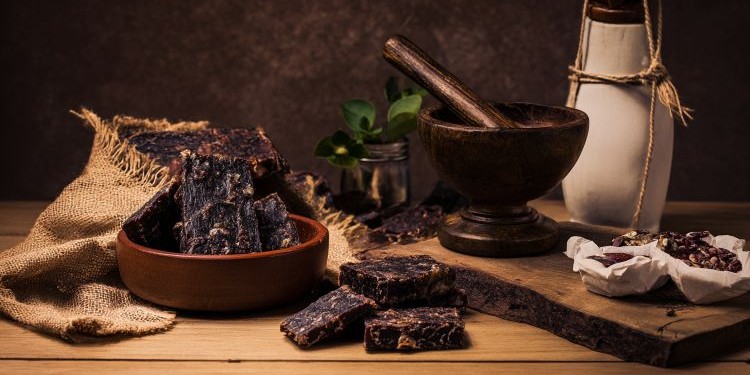
What is pemmican and why should you make it? Pemmican is a high-energy, long-lasting survival food from dried meat, fat, and berries. This guide will show you how to make pemmican, explain its history, and give tips for the best results.
Ever since our very own Claude Davis first made pemmican and shared it with the Ask A Prepper community, 10 years ago, this dish was loved by our readers. And it is very easy to understand why. It is hard to find a better survival food that is so easy to make and nutritious. Every single prepper out there should know how to make it, actually make it, and store it.
Key Takeaways
- Pemmican is a traditional survival food made from dried meat, fat, and sometimes berries, valued for its longevity and nutrient density.
- Key ingredients include lean meats, rendered fat, and salt; proper preparation and storage are essential for maintaining freshness and avoiding spoilage.
- Pemmican is versatile, allowing for personal customization with various meats and flavorings, and can be enjoyed in multiple dishes.
Understanding Pemmican: The Ancient Survival Food
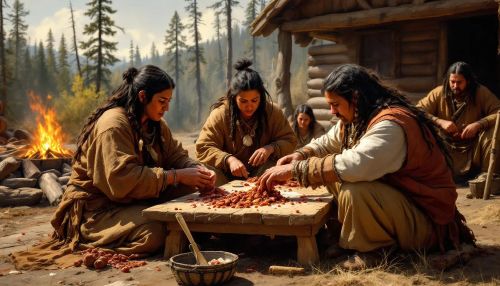
Pemmican, a blend of dried meat, fat, and sometimes berries, was a crucial survival food for North American Indigenous peoples, particularly among northern tribes. The term pemmican derives from the Cree word meaning ‘manufactured grease,’ reflecting its composition and purpose. This ancient food was especially prized for its longevity and resistance to spoilage, making it an essential travel food for explorers and soldiers.
European fur traders quickly adopted pemmican for its practicality during long expeditions. Made by sun-drying meat and grinding it into a fine powder, it was then mixed with rendered fat to create a compact and durable food source. Buffalo meat was often used, providing both the meat and the necessary fat for preservation. The Red River Métis even industrialized the production of pemmican, transporting it in carts for trade at northern posts.
Pemmican’s efficacy was recognized as early as the 18th century, with explorers like Lewis and Clark relying on it for nutrition during their expeditions across North America. While traditional pemmican preparation was a communal activity among Native Americans, modern versions can be made individually in home kitchens, making it accessible to everyone.
Ingredients Needed for Pemmican
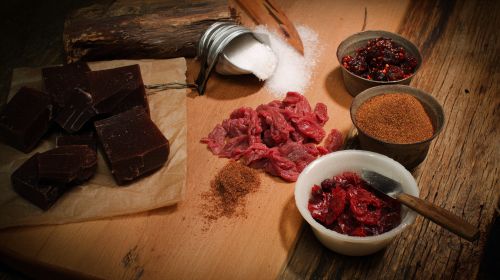
You’ll need a few key ingredients to start making pemmican. The backbone of any pemmican recipe is lean meats, tallow or suet, and salt. Powdered dried beef, bison, venison, or duck are commonly used meats. The fat component is typically rendered from beef or bear tallow, providing the necessary binding and preservation properties.
Start by listing some forbidden ingredients like crushed red pepper can enhance the flavor, and rendered beef or bear fat should be used carefully to maintain the right consistency. Whether you prefer a traditional or modern twist, these small pieces of bone marrow ingredients will set you on the path to creating a high-energy, long-lasting cooked food source that you can eat, using four ounces of the right components, including lard, which may vary depending on your personal taste. Sugar may also be considered in some recipes.
Step-by-Step Guide to Making Pemmican
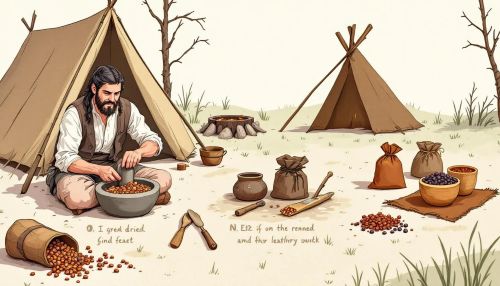
With your ingredients ready, let’s begin the cooking pemmican-making process. This guide provides easy-to-follow instructions to help you achieve the perfect balance of taste and longevity.
First, we’ll prepare the meat, then mix the ingredients, and finally cover the best storage methods to keep your pemmican fresh for years.
Preparing the Meat
Start by preparing the meat:
- Slice the lean meat into thin strips, which will help it dry faster and more efficiently.
- Use a food dehydrator, which is the most effective tool for drying the meat; alternatively, an oven set to a low temperature can also work.
- Dehydrate the meat for approximately 12 hours to ensure it is thoroughly dried.
Grind the dried meat into a coarse powder using a food processor or meat grinder. This step is crucial for achieving the right texture and consistency in your pemmican. Remove all visible fat from the meat before drying to prevent spoilage and ensure a longer shelf life.
Mixing the Ingredients
Once your dried meat is ready, start mixing the ingredients:
- Traditionally, a mortar and pestle or two stones were used to pulverize the pounded dried meat.
- Modern techniques, such as using a food processor, make this task much easier and quicker.
- Melt the bison fat on low heat until it becomes a clear liquid, taking care not to overheat it.
Combine the ground meat and melted fat in a large mixing bowl, mixing thoroughly for an even consistency. The suggested meat-to-fat ratio is equal weight, but you can adjust this based on personal taste. Tasting during the mixing process helps achieve the perfect flavor balance in your final product.
Storing Your Pemmican
Maximizing the shelf life of your pemmican stored requires proper storage. Follow these guidelines:
- Keep your pemmican in a cool, dry place away from direct sunlight.
- Maintain ideal storage temperatures between 60°F and 70°F.
- Wrap the pemmican tightly in wax paper before placing it in an airtight container to help maintain its freshness.
Humidity can lead to spoilage and mold growth, so avoid stored pemmican in such conditions. With the right storage conditions, your pemmican can last for years, making it an excellent survival food for emergencies or long periods of adventures.
Remember This!
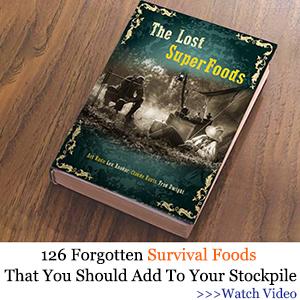 They tell you pemmican is outdated. “Unnecessary.” “Primitive.”
They tell you pemmican is outdated. “Unnecessary.” “Primitive.”
But why did ancient warriors, explorers, and indigenous tribes trust it with their lives—while our shelves are stocked with food that rots in days?
Pemmican was just the start. There’s a reason these survival foods were buried for generations. They don’t rely on freezers. They don’t rot in a week. They don’t make you dependent.
👉 The Lost Survival Foods brings it all back—the lost methods, the forgotten preservation hacks, the meals that kept people alive when empires fell.
And you won’t find this in any supermarket aisle.
Grab your copy before the next “shortage” hits.
Nutritional Value and Health Benefits
Packed with high protein and healthy fats, pemmican is a protein packed nutritional powerhouse. This combination offers a concentrated source of high-quality energy, vital for sustained endurance. Unlike typical snacks, pemmican offers a balanced nutrient profile, combining protein, fat, and sometimes dried fruits for a complete meal.
Rich in essential vitamins and minerals like A, D, E, K, iron, and zinc, this traditional food supports overall health. Pemmican’s gradual release of energy helps maintain prolonged satiety, making it an ideal food for long-lasting physical activities. Its easy digestibility ensures clean energy without the digestive issues often associated with processed foods.
Traditional Methods vs. Modern Techniques
The process of making pemmican has evolved, blending traditional methods with modern techniques. Traditionally, the process involved:
- Drying and pulverizing meat manually using tools like stones or a mortar and pestle.
- Combining the pulverized meat with rendered animal fat.
- Storing the mixture in bison hide bags to prolong its shelf life.
Modern pemmican recipes benefit from technological advancements like food processors for grinding meat and airtight containers for better preservation. Traditional methods relied on natural drying and fat rendering, while modern techniques may use preservatives to extend longevity. Despite these differences, both methods aim to create a durable, high-energy food source.
Different Recipes and Variations
Pemmican’s versatility is one of its best aspects. You can adjust the meat-to-fat ratio based on personal preference, allowing for customization. Other ways to enhance the mixture include:
- Adding dried fruits like cherries and blueberries to enhance flavor and sweetness
- Adding crushed red pepper for a spicier kick
- Adding optional honey for a sweet-spicy flavor
You can press pemmican into bars with seeds and dried fruits, dried berries, and dried cherries to create portable snacks. These fruit recipes and variations offer a wide range of flavors and textures, whether you prefer a traditional or modern twist.
Serving Suggestions and Uses
Its long shelf life makes pemmican an ideal food for emergencies, camping trips, and long-term survival scenarios. You can enjoy pemmican as is or incorporate it into various dishes. Add thin slices of pemmican to soups and stews for an extra protein boost. Crumbled pemmican makes a crunchy topping for salads, adding flavor and nutritional value.
For breakfast, add chopped pemmican to omelettes or scrambled eggs. Use it as a filling for tacos or wraps alongside vegetables and salsa. The possibilities are endless, and pemmican’s versatility ensures it can be enjoyed in numerous ways.
Common Mistakes to Avoid When Making Pemmican
Avoiding common mistakes is crucial for successful pemmican preparation. One crucial step is removing all visible fat from the meat before drying. Failing to do so can lead to spoilage and reduce the shelf life of your pemmican. Ensure the meat is completely fat-free before grinding and mixing with rendered fat.
Heat the rendered fat slowly until it becomes a clear liquid. Overheating can alter the fat’s properties and negatively affect the final product. Pay attention to these details to ensure your pemmican is both delicious and long-lasting.
Final Thoughts
To sum up, pemmican is a remarkable food that has stood the test of time. Its rich history, nutritional value, and versatility make it an enduring favorite for survivalists and adventurers alike. By following this guide, you can create your own pemmican at home, tailored to your taste and needs. Embrace the tradition and enjoy the benefits of this ancient superfood.
Frequently Asked Questions
What is pemmican made of?
Pemmican is primarily made of dried meat and rendered fat, with the occasional addition of dried fruits or berries for flavor. It’s a nutrient-dense food that’s great for energy!
How long can pemmican be stored?
Pemmican can last for years if you store it properly in a cool, dry place. So, it’s a great survival food!
Can I use any type of meat for making pemmican?
Absolutely, you can use various lean meats like beef, bison, or venison for making pemmican, so feel free to get creative! Just remember to stick to lean cuts for the best results.
What is the ideal meat-to-fat ratio for pemmican?
The ideal meat-to-fat ratio for pemmican is equal weight, but feel free to tweak it to suit your taste!
How can I add flavor to my pemmican?
Adding dried fruits, crushed red pepper, honey, or your favorite spices can really enhance the flavor of your pemmican. Just mix in what you like, and you’ll enjoy a more delicious treat!
You may also like:
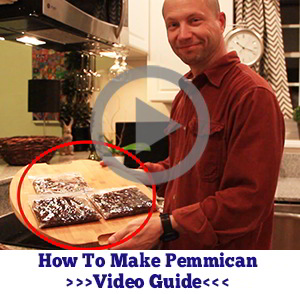 Pemmican vs. Spam. Which is the best food for survival?
Pemmican vs. Spam. Which is the best food for survival?
Learn How to Keep Eggs Fresh for at Least a Decade (Video)
Why Cow Sharing is Illegal and How It Can Save Your Life
Where to Buy Natto – The Japanese Fermented Superfood
Depression-Era Foods Making a Comeback
Read the full article here









